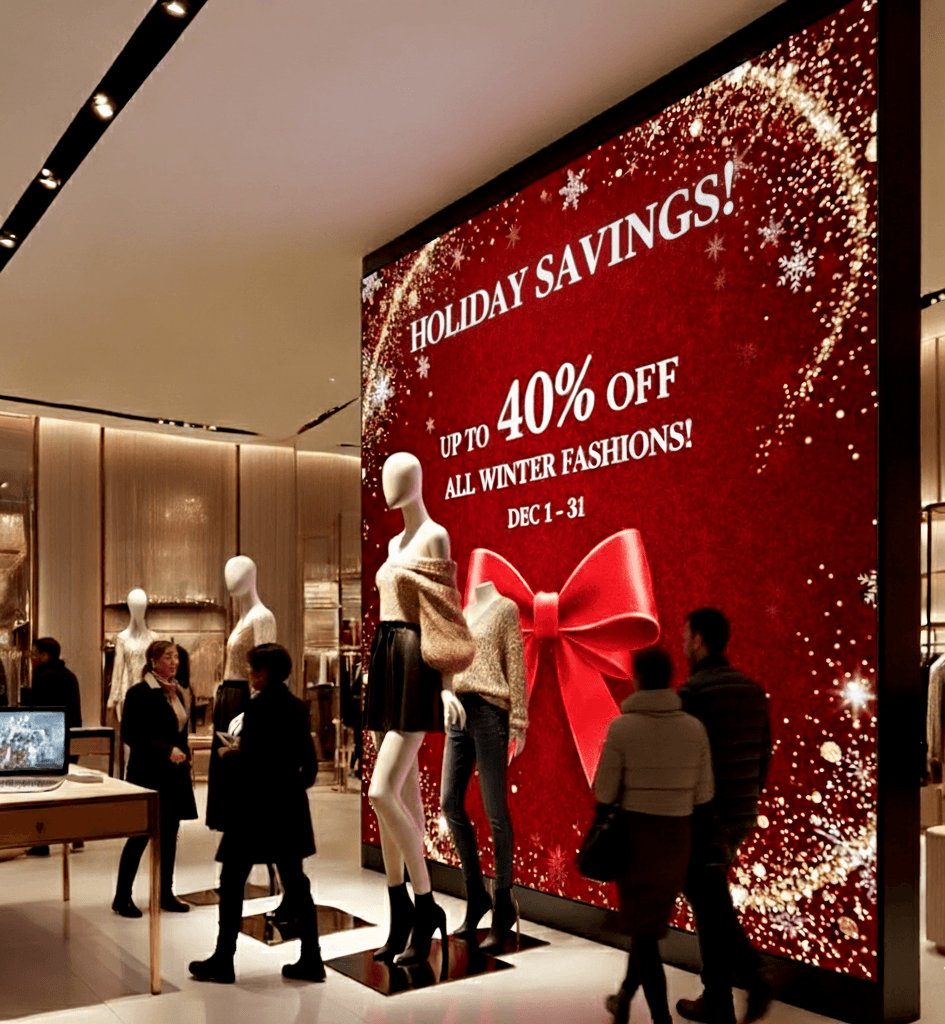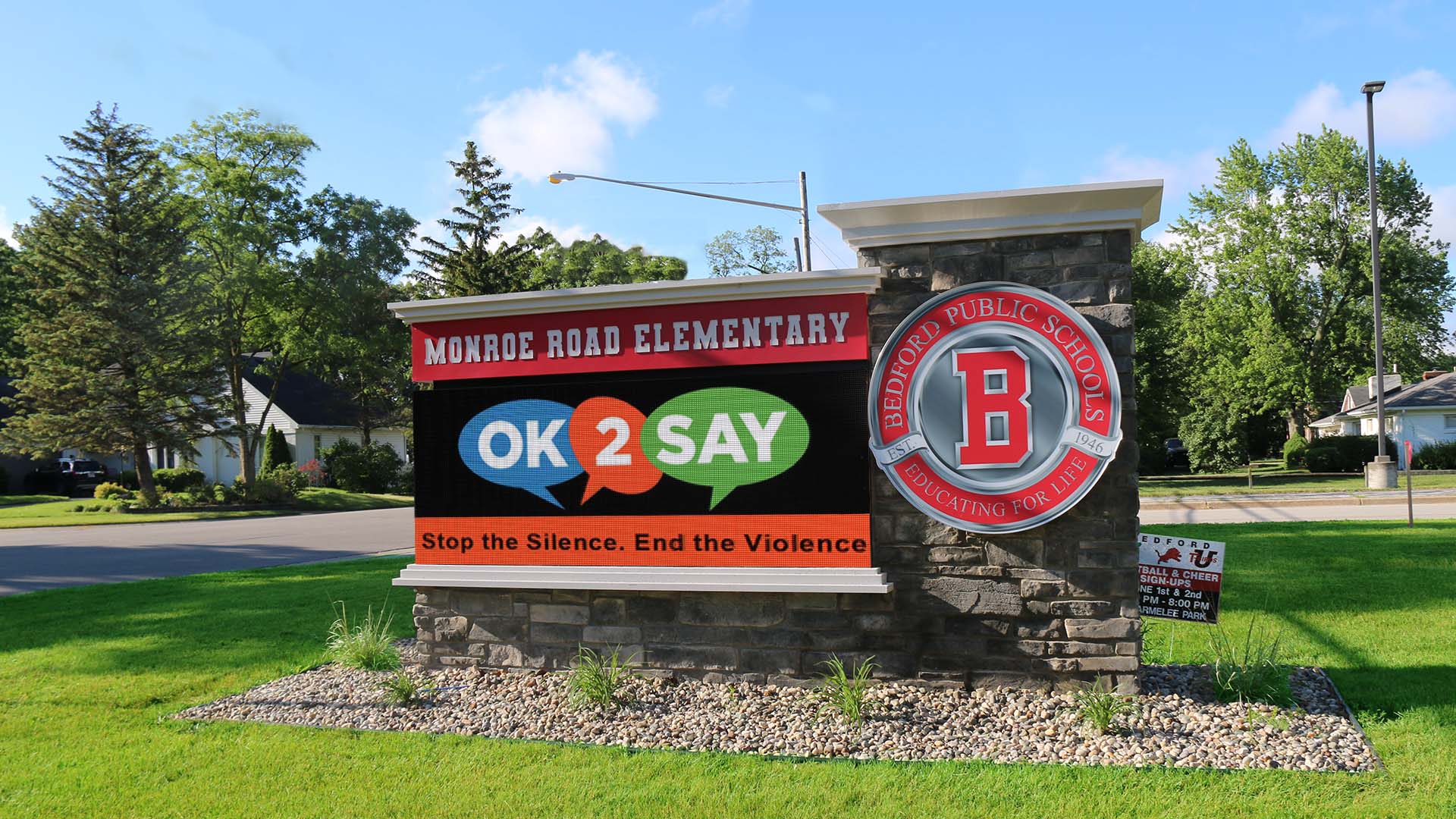When customers walk into a store, their first impression shapes how long they stay, how much they buy, and whether they return. LED displays play a big role in creating that premium in-store experience. Bright, dynamic visuals elevate the atmosphere, deliver information instantly, and set your brand apart from competitors.
What is retail digital store signage?
Retail digital store signage refers to screens (LED displays, video walls, kiosks) installed inside shops, controlled by a centralized CMS, that dynamically present content like promotions, wayfinding, messaging, or interactive interfaces. These displays let stores update messaging instantly across locations and tailor visuals by zone or time of day without reprinting.
What are the benefits of digital signs in retail?
Digital signage offers speed, flexibility, and impact. Because screens can be updated, retailers eliminate printing cycles—saving cost and reducing waste. Visual recall is strong in hardware-enabled environments: digital signage enjoys an 83% recall rate, far surpassing static media. Customer behavior proves the payoff: 80% of customers say they entered a store because a digital sign caught their interest. And many retailers report average sales increases of 31.8% after deploying indoor digital signage.

What type of signage is used in the retail store?
Retail setups commonly include:
LED displays and panels for product zones
Video walls for striking visual centers
Digital kiosks or interactive signage for self-service, product lookup, or loyalty logins
Wayfinding screens in complex layouts
Video walls often comprise 27% of the digital signage market and serve as attention magnets by anchoring focal areas.
How do you use indoor LED signs to increase sales?
Place displays near categories, point-of-sale, or high-interest zones. Use them to cross-sell accessories, highlight limited-time discounts, or rotate visuals that guide shoppers toward add-ons. Because digital signage captures 400% more views than static displays, you have a better chance at influencing decisions. At checkout, small screens or impulse messaging can drive incremental purchases: 19% of consumers report making impulse buys after seeing digital ads.
What is the cost of an in-store retail digital store signage system?
While hardware, software, installation, and training vary by scale, many retailers estimate that total system cost amortizes over 3–5 years through increased revenue and operational savings. You gain 30–35% reductions in advertising and printing costs and cut labor for signage changeovers.
Is retail digital store signage easy to use?
Yes—modern CMS platforms make it simple. Team users or store managers can swap visuals by location, schedule daily content, and preview changes. Because digital displays allow updates instantly, 95% of users rank ease-of-update among the top benefits.
How is digital signage installed?
Displays install via wall mounts, ceiling brackets, freestanding enclosures, or recessed setups. Media players plug into each display (or cloud-based systems stream content). Network connectivity ensures updates sync instantly. For retail chains, installs scale with rack-mount players and managed rollout plans.

How can you use LED in a retail environment?
Use LED displays for product showcases, ambient messaging, digital shelf tags, sizing guides, and window displays. LED panels excel in bright zones—thanks to high brightness and contrast—and can combine with touch capabilities for interactive features. Their modular nature allows video walls to scale across walls or pillars.
How can a small business maximize in-store signage?
Start with a few high-impact zones—entrance, checkout, and a cross-sell aisle. Use templated content you can rotate weekly. A/B test messages. Use your display network as a mini retail media network by showcasing brand partnerships. Even one display can pay for itself when paired with smart content and location strategy.
What content ideas drive sales and engagement?
Run rotating promotions, spotlight top sellers, use subtle motion to draw attention, run loyalty or member offers, countdown timers for flash deals, and display product testimonials or social media feeds. Tailor by daypart—morning, lunch, evening. Mix brand storytelling with hard sells to keep environments engaging.
What should be displayed on digital signage in a store?
High-level recommendations:
Short headlines and supporting lines
Clear call to action (e.g. “See this at aisle 5”)
Imagery or video with product visuals
Dynamic offers that change by time or inventory
Localized content per store
Wayfinding cues
Loyalty or coupon prompts
How can digital signage enhance the in-person shopping experience?
Good signage informs, engages, and reduces friction. It helps shoppers find what they want, highlights helpful options, and delivers timely offers. Rather than wandering, customers feel guided. That sense of clarity, coupled with visual dynamism, transforms a store into a smart, immersive environment.
Why NEXT LED Signs is the Right Choice
Delivering a premium in-store experience requires technology that is bright, reliable, and easy to manage. NEXT LED Signs manufactures indoor LED displays engineered for clarity and performance. Our video walls and programmable signage are designed to capture attention, guide customers, and enhance brand presence. Every display comes with cloud-based software for simple updates, giving retailers the flexibility to keep content fresh and relevant.
With in-stock products, fast five-day shipping, and strong dealer support, NEXT LED Signs makes it easy for retailers to create in-store experiences that customers remember.
Ready to elevate your store with a premium in-store experience? Contact NEXT LED Signs today for a free quote and see how fast, reliable LED displays can transform your retail space.+
- FAQs About LED Signage for Retail Stores
- How quickly can retailers see ROI from in-store digital signage?
Many programs reach positive ROI in 6–18 months, and some case studies report payback in ~11 months depending on scale and content effectiveness. - Where should stores place signage to improve wayfinding and reduce shopper stress?
Put displays at decision points (entrances, aisle junctions, service counters). Smart wayfinding has been shown to cut shopper stress by ~20%, which helps keep dwell time and satisfaction up. - Does dwell time on digital displays correlate with better outcomes?
Yes—longer on-screen engagement is linked with up to 30% higher recall and up to 20% higher conversion rates when content is relevant. - Are LED displays the preferred hardware for retail digital signage?
Yes. The LED segment accounts for roughly 48.5% of the retail digital signage market, reflecting retailer preference for brightness, durability, and clarity. - Do shoppers actually notice and act on in-store digital displays?
They do: 58% of shoppers say they actively notice digital displays in stores, and nearly half report that screens influence their purchase decisions. - Can switching from static posters to dynamic screens increase impulse purchases?
Yes—one documented rollout saw impulse buys climb by 27% after moving from static to digital, especially near POS and high-traffic aisles. - What impact does personalization have on retail screen performance?
Personalized, context-aware content has driven ~27% gains in engagement, particularly when messages reflect location, time of day, or shopper profile. - What’s a practical first step for small retailers?
Start with one or two premium in-store LED displays near the entrance and checkout, build a weekly content cadence, and test A/B variations. Expanding in phases keeps costs predictable while you validate impact.



